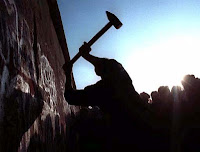Tear down these walls.

Learning is not something that is ‘done’ to a student by a teacher. Learning only happens when a student chooses to engage with what is being taught. But, obviously learning can also happen without a teacher. Regardless of how old we are, whether we ‘succeeded’ in school or not, learning is what humans do. As long as we live, learning is a choice. Traditional schooling was (is?) about a teacher imparting knowledge perceived to be useful to a group of students. This happened in an enclosed space, for a fixed time and with no outside influence or interference for the duration of the ‘lesson’. Exams, assignments and essays were, and often still are, done alone. In the industrial society where these students left school and entered factories, this was good preparation for their lives as adult workers – performing repetitive tasks, probably alone, in an enclosed space and under supervision and with little or no outside interference. So does traditional schooling as described st...
